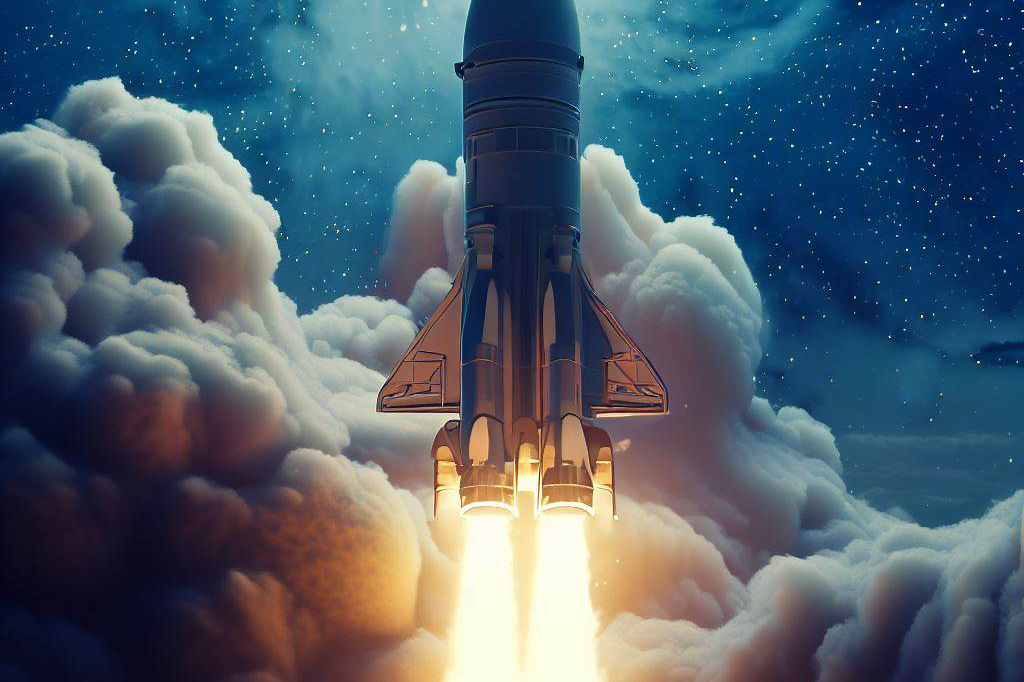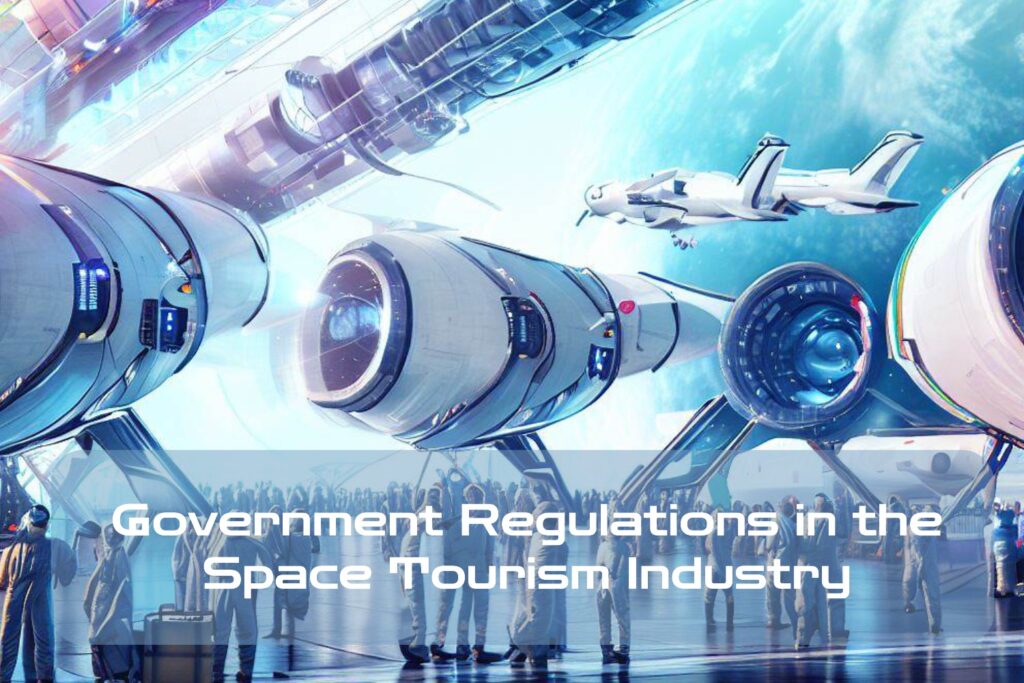The Space Tourism Industry: An Overview
Space tourism is the practice of traveling into space for recreational purposes. This industry is relatively new and has been growing rapidly in recent years thanks to advances in technology and private sector investments.
Companies like Virgin Galactic, Blue Origin, SpaceX, and Boeing have been developing spacecraft that can carry passengers beyond Earth’s atmosphere and into space. The concept of space tourism dates back to the 1960s when NASA began training civilians for potential space flights.

However, it wasn’t until the early 2000s that the industry started to take shape with the first privately-funded suborbital flight by SpaceShipOne. Since then, there have been several successful suborbital flights, orbital missions to the International Space Station (ISS), and plans for lunar tourism.
The Importance of Government Regulations
While private companies are leading the way in developing space tourism technologies, government regulations play a crucial role in ensuring safety and sustainability in this industry. The lack of clear regulations could lead to accidents or environmental damage that would not only harm individual passengers but also set back progress in this fledgling industry. For instance, government agencies like NASA and FAA set safety standards for spacecraft design, testing, and operation.
They also monitor environmental concerns such as emissions from launch vehicles or waste disposal from spacecraft operations. In addition, governments establish legal frameworks to deal with liability issues should accidents occur during space tourism activities.
Without these key regulations in place, investors may be hesitant to fund new projects due to concerns over safety or liability risks. Ultimately, government regulations help promote responsible practices while allowing room for growth in this exciting industry.
Safety Regulations: Keeping Passengers Safe in Space

The safety of space tourism activities is a top priority for government agencies such as the Federal Aviation Administration (FAA) and NASA. They have a key role to play in regulating the industry, ensuring that safety requirements are met, and accidents are minimized.
Spacecraft design is an essential aspect of safety regulations in the space tourism industry. The spacecraft must be designed to withstand the harsh conditions of spaceflight, including extreme temperatures, radiation exposure, and microgravity.
In addition, spacecraft must be equipped with sufficient safety features, such as escape systems and fire suppression mechanisms, to ensure that passengers can return safely to Earth in the event of an emergency. Before any spacecraft can fly tourists into space, they must undergo rigorous testing and certification by government agencies like the FAA.
This ensures that every aspect of the vehicle’s design and operation meets strict safety standards. Even after certification, regular inspections are conducted to ensure that all systems are functioning correctly.
Unfortunately, accidents have occurred during space tourism activities that have led to tighter regulations on industry operations. One notable incident was the 2014 crash of Virgin Galactic’s SpaceShipTwo during a test flight over California’s Mojave Desert, which resulted in one fatality and one serious injury among the crew members aboard.
The incident led to significant changes in test flight procedures and stricter requirements for pilot training before allowing commercial flights into space. Government agencies continue reviewing their regulations continually so they keep up with technological advancements in spacecraft design.
Environmental Regulations

Impact of Space Tourism on the Environment
Although space tourism is a thrilling and innovative experience for many, it’s important to consider the impact it has on our planet. The space tourism industry contributes to greenhouse gas emissions through rocket launches, which can have a harmful effect on the Earth’s atmosphere. Additionally, waste disposal in orbit can cause long-term pollution and debris that could threaten future space missions.
As the industry grows, it is essential that we take steps to mitigate these environmental impacts. With more frequent launches planned in the future, regulations must be put in place to limit pollution and preserve our planet.
Government Efforts to Regulate Emissions, Waste Disposal and Other Environmental Concerns
Governments around the world have recognized the need to regulate space tourism activities with environmental protection in mind. The Federal Aviation Administration (FAA) in the United States has proposed new rules that would require companies launching spacecraft from U.S. soil to offset their carbon emissions by purchasing carbon credits or participating in other initiatives aimed at reducing their carbon footprint.
Additionally, some governments are working towards developing environmentally-friendly fuel alternatives in an effort to reduce GHG emissions caused by rocket launches. Governments are also encouraging recycling practices for discarded spacecraft parts and waste disposal measures during missions so that they do not cause detrimental effects on our planet.
Challenges in Balancing Economic Growth with Environmental Protection
One of the major challenges faced when implementing environmental regulations in space tourism is balancing economic growth with environmental protection. Although governments are making efforts to regulate emissions and waste disposal practices during missions, stricter regulations might limit profits for businesses operating within this industry.
However, one possible solution could be government incentives or subsidies provided towards research for environmentally-friendly solutions such as alternative fuels or sustainable materials used during the production process of spacecraft. This would benefit both businesses and the environment.
The Legal Side of Space Tourism

Who’s Responsible When Something Goes Wrong?
Space tourism is a relatively new industry, and as such, there are many uncertainties surrounding liability in the event of accidents or injuries. One of the main issues is determining who is responsible for accidents that occur during space tourism activities.
Is it the company providing the service?
The passenger who signed a waiver?
The government agency that approved the launch?
To address these concerns, governments have developed policies on insurance requirements, waivers, and other legal aspects.
For example, in the United States, companies providing space tourism services must obtain informed consent from passengers and carry insurance to cover potential damages or injuries. In addition, passengers are required to sign a waiver acknowledging the risks involved.
The Role of International Treaties and Agreements
Space activities are subject to international law, including treaties and agreements governing space exploration and use. The most widely recognized treaty is the Outer Space Treaty of 1967, which sets out basic principles for peaceful use and exploration of space by all nations.
Other important agreements include the
- Liability Convention of 1972 (which outlines liability for damage caused by space objects),
- the Registration Convention of 1976 (which requires states to register their space objects),
- and the Rescue Agreement of 1968 (which obligates states to provide assistance to astronauts in distress).
As more countries develop their own space tourism industries, international cooperation will become increasingly important in shaping regulatory frameworks.
The Future Challenges
As with any new industry, there will likely be legal challenges as more companies enter the market and push boundaries. One issue that has already arisen is government oversight versus industry self-regulation. Some argue that governments should take a hands-off approach in order to promote innovation and growth within the industry.
Others argue that tighter regulations are necessary to ensure safety and protect consumers. The future of legal regulations in space tourism will likely depend on a delicate balance between economic interests, public safety concerns, and international cooperation.
Economic Regulations

Role of Government Incentives and Subsidies in Promoting the Growth of Space Tourism
The development of space tourism requires a significant amount of investment and expertise. Therefore, the government plays a vital role in promoting the growth of this industry through various incentives and subsidies. The government provides financial support to space tourism companies for research and development, infrastructure development, spacecraft design, and launch operations.
In addition to financial support, the government also offers tax breaks, regulatory exemptions, and other benefits to encourage private sector participation in this field. Governments incentivize private companies to invest in developing new technologies that can be used for space tourism operations.
Challenges in Balancing Economic Benefits with Public Interest
While economic benefits are essential for promoting the growth of the space tourism industry, it is equally important to ensure that public interest is protected. The government must strike a balance between encouraging private sector participation while ensuring safety regulations are met.
Moreover, there is a need for responsible environmental practices in space travel to prevent long-term damage both to our planet’s atmosphere as well as that on other planets that we may visit. Another challenge comes from balancing economic benefits with ethical considerations about who should be allowed access.
Examples of Successful Government Initiatives Supporting Private Sector Innovation
Over time, there have been several successful government initiatives that have supported private sector innovation within space tourism. One example is NASA’s Commercial Crew Program (CCP), which aims to develop safe and cost-effective transportation systems for ferrying astronauts between Earth and low-Earth orbit. The United States Congress passed legislation supporting commercial human spaceflight services with indemnification provisions under which the U.S. government would indemnify commercial providers against third-party claims arising from their licensed activities if such claims exceeded their insurance coverage limits.
Another example comes from SpaceX’s partnership with NASA, which results in their ability to provide affordable and reliable commercial services for the transport of cargo to the International Space Station (ISS), enabling more research in space.
Government initiatives are vital in promoting growth within the space tourism industry, and private sector companies play a significant role in developing the technology needed to accomplish its goals.
Potential Changes in Government Regulations as the Space Tourism Industry Evolves

The space tourism industry is still in its infancy, and as it grows and evolves, government regulations will need to adapt accordingly. One potential change that we may see is a shift towards more streamlined and standardized regulatory frameworks across different countries. Currently, regulations vary widely from one country to another, which can make it difficult for companies operating in the space tourism industry to navigate these different requirements.
However, there are already efforts underway to harmonize regulations, such as the 2010 Space Tourism Guidelines issued by the United Nations Office for Outer Space Affairs (UNOOSA). Another potential change is an increased focus on sustainability and environmental protection.
As we mentioned earlier, there are already some regulations in place that address these issues (such as emissions limits), but these may need to be strengthened or expanded as the industry grows. In particular, regulators may want to consider ways to reduce the amount of space debris generated by space tourism activities, which poses a risk not just for other spacecraft but also for people on Earth.
We may see changes in the liability rules governing space tourism activities. Currently, many companies require passengers to sign waivers absolving them of any responsibility in case of injury or death during their flight.
However, some experts argue that this approach places too much burden on individual passengers and shifts responsibility away from companies, which should be held accountable for any accidents or incidents that occur. In the future, regulators may look for ways to strike a better balance between protecting passengers’ rights and ensuring accountability among industry players.
Opportunities for International Cooperation and Collaboration on Regulatory Frameworks
Given the global nature of the space tourism industry (with flights likely taking off from one country but traveling into another’s airspace), international cooperation will be key in developing effective regulatory frameworks. There are already some examples of successful cooperation between countries in this regard, such as the European Union’s Single European Sky initiative, which aims to harmonize air traffic control regulations across different countries.
One opportunity for collaboration is in the area of safety standards. As we mentioned earlier, space tourism activities are currently regulated by a patchwork of different agencies and organizations around the world, which can make it difficult for companies to navigate.
However, if these various groups were able to agree on a common set of safety standards and requirements (perhaps through an international treaty or agreement), this could help establish a more level playing field for all companies operating in the industry. Another area where international cooperation could be valuable is in developing guidelines or best practices around environmental protection.
As we discussed earlier, space tourism activities have the potential to generate significant amounts of waste and emissions that could harm the environment. By working together to establish common goals and standards in this area, countries could help ensure that the growth of the space tourism industry does not come at too high a cost.
Overall, while there are certainly challenges involved in developing effective government regulations for the space tourism industry, there are also many opportunities for collaboration and innovation. By working together across borders and disciplines, we can help ensure that this exciting new frontier is explored safely and sustainably for generations to come.
The Role of Government Regulations in Shaping the Future of Space Tourism
Without clear guidelines on safety standards, liability issues, and environmental concerns, it would be challenging for private companies to navigate the complex legal landscape of space activities. As we have seen with recent incidents like SpaceX’s Crew Dragon explosion during testing in 2019, it is crucial to have robust regulations in place to mitigate risks and ensure public trust.
Moving forward, there are many exciting opportunities for governments around the world to collaborate on developing new regulatory frameworks for space tourism. As more countries enter the race to explore space and offer commercial services like suborbital flights or lunar landings, it will become increasingly important to coordinate efforts and establish common standards for safety and sustainability.
The Outer Space Treaty of 1967 provides an excellent foundation for international cooperation on peaceful uses of outer space, but there is still much work to be done in adapting these principles to modern developments. Overall, we can expect government regulations to continue playing a vital role in shaping the future of space tourism.
Whether through providing incentives for innovation or enforcing strict safety requirements, policymakers will need to balance economic interests with public welfare concerns as they navigate this exciting frontier. By working together across borders and sectors, we can achieve a bright future where humans can boldly explore new horizons while preserving our fragile planet for generations to come.
TL;DR
– ✈️ Space tourism is a rapidly growing industry driven by advancements in technology and private sector investments.
– 🚀 Government regulations play a crucial role in ensuring safety and sustainability in the space tourism industry.
– 🌍 Environmental regulations are needed to mitigate the impact of space tourism on greenhouse gas emissions and space debris.
– ⚖️ Legal aspects of space tourism include determining liability and the role of international treaties and agreements.
– 💰 Government incentives and subsidies are important for promoting the growth of the space tourism industry.
– 🌐 International cooperation is crucial in developing effective regulatory frameworks for space tourism.
– 🛰️ Government regulations will shape the future of space tourism by ensuring safety, mitigating risks, and balancing economic interests with public welfare concerns.
FAQs
1. What is space tourism?
– Space tourism refers to the practice of travelling into space for recreational purposes. It involves individuals or groups experiencing spaceflight and exploring beyond Earth’s atmosphere.
2. Why has the space tourism industry been growing rapidly?
– The space tourism industry has experienced significant growth in recent years due to advances in technology and increased investments from private sector companies. This has led to the development of spacecraft capable of carrying passengers into space, such as those by Virgin Galactic, Blue Origin, SpaceX, and Boeing.
3. What role do government regulations play in space tourism?
– Government regulations play a crucial role in ensuring safety and sustainability in the space tourism industry. They establish safety standards for spacecraft design, testing, and operation. Government agencies like NASA and FAA monitor environmental concerns, set emissions limits, and address waste disposal from space activities. They also establish legal frameworks to deal with liability issues.
4. Why are government regulations important for the space tourism industry?
– Clear regulations are essential to prevent accidents or environmental damage that could harm passengers and hinder industry progress. Without regulations, investors may be hesitant to fund projects due to safety and liability risks. Government regulations promote responsible practices while allowing room for growth in this exciting industry.
5. How do government regulations ensure passenger safety in space tourism?
– Government agencies like the Federal Aviation Administration (FAA) and NASA prioritize safety in space tourism activities. They regulate spacecraft design, requiring them to withstand the harsh conditions of spaceflight and be equipped with safety features like escape systems. Rigorous testing and certification processes ensure that all aspects of a vehicle’s design and operation meet strict safety standards. Regular inspections are conducted to ensure proper functioning.

C M, a seasoned editor, journalist, and consultant, is deeply fascinated by the convergence of technology, space, and the future of humanity.
With a particular interest in transhumanity, futurology, and the philosophical and ethical dimensions of these domains, C M serves as the lead contributor to SpaceSpotlight and TranscendSphere.
When not penning insightful articles on these rapidly evolving fields, C M indulges in their love for podcasts and books, proudly embracing their status as a ‘Happy Nerd Extraordinaire!’



